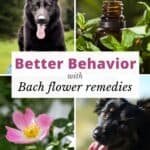Most dog behavior and training problems have an emotional side to them. When dogs get angry, impatient, bossy, jealous, or fearful, it can lead to difficult, challenging behavior. Flower remedies improve dog behavior indirectly, by balancing emotions. In this article, a professional dog trainer explains how Bach flower remedies can help your dog behave better.
Flower remedies (also known as flower essences) excel at correcting or adjusting extreme or out of balance emotions. They work in people and all animals, including dogs.
Why is this important?
Because like us, dogs are emotional creatures. And as such, they’re subject to a range of behavior problems that are influenced by their emotional state.
And when a dog’s emotions are balanced, their behavior is more reasonable and less extreme, and they’re able to learn more easily.
I’m a dog trainer with 30 years experience working successfully with all kinds of training and behavior problems. I’ve worked on problems for weeks (months, longer) through proven training methods, behavior modification, solid leadership, and all-important structure.
I’ve trained dogs with the help of flower remedies and without. I’ve used them early in the process as well as later (generally after feeling I had gotten so far and couldn’t get further).
My conclusion?
Flower remedies make my job as a dog trainer easier. And they can do the same for you.
Flower essences help the dog adapt more easily and learn lessons more quickly and thoroughly. And as a dog professional dog trainer, pet owner, and dog sports competitor, those things are important to me!
So, if you’ve asked yourself, why try Bach flower remedy therapy for dogs? My question would be – why in the world would you not?
What dog behavior problems can Bach flower remedies help improve?
Bach flower remedies can be of tremendous practical help with a wide range of dog training and behavior problems.
Basically, If the behavior has an emotional component, flower remedies can help.
While there are many types of dog behavior issues that can be helped by flower essences, there are three main ones where it’s actually pretty common to see them used in dogs:
Those all fall within the realm of “dog anxietyâ€, but there are some significant differences, emotionally speaking, between the three.
Bach flower remedies excel at relieving fear and anxiety in dogs
Do you have a nervous, timid, shy dog with general anxiety? Or maybe a dog that’s not generally nervous but that has one or more specific fears?
Bach flowers can do wonders for these types of dog.
Common fears that tend to respond well to flower remedies are noise sensitivities like thunder phobia, fear of fireworks, and gun shyness. But frankly, flower remedies are pretty amazing in general when it comes to improving confidence and courage and relieving fears of almost any kind.
Interested in learning more about how Bach flower essences can help fearful dogs? My Bach Flower Guide on Stress, Fear and Anxiety Relief for Dogs is an in-depth look and gives specific recommendations on choosing specific flower essences for anxious, fearful dogs.
Flower remedies are an important tool in separation anxiety training
Separation anxiety in dogs tends to stand alone as a type of canine anxiety. It goes beyond insecurity and is often associated with the nature of the relationship with the owner.
Dogs with separation anxiety may be overly dependent on their owners for their own sense of security, and many have overly strong levels of attachment (often formed after a traumatic break in their last relationship – i.e. rehoming).
While Bach’s Rescue Remedy can be very effective in relieving the stress and panic of separation anxiety, I’ve found it’s helpful to use additional Bach flower essences that address any attachment and relationship issues that may be present (which they can do with remarkable effectiveness).
If you’d like to read more about this, my article Bach Flowers and the Emotions of Separation Anxiety in Dogs looks thoroughly at the issue, and offers a selection of flower essences that can help relieve the emotional symptoms.
Bach flower remedies can ease travel anxiety
Travel anxiety in dogs is another area where Bach’s Rescue Remedy is a standout. It’s the go-to treatment of choice for many holistically-minded dog owners, since it’s so successful in relieving the stress and panic of car rides.
However, when Rescue Remedy isn’t enough, there are a number of flower remedies that can fill out the emotional picture seen in dogs with travel anxiety. I like to include Bach flowers which help alleviate anxiety, fear, disorientation, and nervous shaking, to name a few.
Does your dog suffers from car travel anxiety? Find training tips and get Bach flower recommendations for dogs that get stressed or panicky on car rides.
Other dog behaviors Bach flower remedies can help improve
Beyond the “Big 3†discussed above, there are several more areas where flower remedies can really help dogs, which I find people are far less likely to think of (and which I didn’t think of myself, for quite a few years). These include:
- reducing dog aggression, suspicion, and jealousy
- calming high-strung, hyperactive dogs
- reducing reactivity including leash reactivity in dogs
- toning down bossy, dominant, controlling behavior in dogs
- helping dogs be more resistant to over-stimulation, lack of focus, and other learning and performance-related issues
- and improving confidence and independence in needy, clingy, excessively attention-seeking dogs
- stabilizing dogs going through intense transitions such as rescue and rehoming, spaying and neutering, and life stages like adolescence and old age.
For all of these issues, I’ve seen many examples of very significant behavior improvement once the right flower essences are introduced into a decent behavior-training program. Often the dog owners are trying flower essences as a last-ditch effort, and end up wishing they had tried them much sooner!

How do flower remedies work?
How do flower remedies adjust attitude and emotion?
It’s a good question.
In the 1930’s, Dr. Edward Bach was working with the idea that emotional states have unique frequencies. His groundbreaking discovery was that there are plants freely growing in nature that contain identical frequencies. And – that the water infused with these flowers will hold an imprint of sorts (or “essenceâ€) of the positive, balanced state of the emotion.
If you’ve ever smelled a rose and been transported, or some honeysuckle and felt wistful, you have an idea of how flowers seem to represent very particular emotions.
But Bach’s discovery made it clear that there was more than the effect of a heavenly scent at work. There was actually a very subtle, but very real, energetic influence.
Over the course of several years, with much experimentation, trial and error, he identified flower species that could act as a kind of positive (i.e. emotionally healthy) template for 38 individual emotional states.
When a person or animal uses a flower remedy, an energetic pattern is presented to the body that represents the “idealâ€, healthy state of an emotion. Over time, their emotional response begins to mirror this template and move back to a more centered, balanced state.
And okay, I totally hear you if you think that all sounds a little “out thereâ€. ?
My own education and background are in the biological sciences, and I definitely lean toward healthy skepticism when encountering techniques or products that seem to lack clear explanation.
That said, I also realize that there is a whole universe of processes and events that we don’t fully understand. After all, virtually every scientific and medical notion that we now accept as established, was not long ago considered unexplained and “mysteriousâ€.
The living body appears to be capable of responding, reacting, and adjusting to subtle “energiesâ€, for lack of a better word, that are not currently measurable given our current level of technology. The same can be said of other alternative therapies in common use, like acupuncture, color therapy, music therapy, and homeopathy. We know they have value, but do not know precisely how they work.
When a person or animal uses a flower remedy, an energetic pattern is presented to the body that represents the “idealâ€, healthy state of an emotion. Over time, their emotional response begins to mirror this template and move back to a more centered, balanced state.

How to give flower essences to your dog
There are actually several ways you can give flower essences to your dog. By far the most common way is to take them internally, either directly or in food or water. But there are alternatives if that poses a problem for any reason.
- Flower remedy drops can be dripped right onto your dog’s tongue or gums. (This works well for mixed formula bottles as the taste is quite mild. If you’re using the tiny 1/4 ounce concentrated stock bottles, the amount of brandy preservative is higher and the taste may be unpleasant if used straight.)
- A close second method in popularity is to give your dog the drops after adding them to a dog biscuit, a small snack, or his food bowl.
- A method growing in popularity is to apply flower remedies topically. You can rub the drops onto your dog’s ear or nose leather, or even onto acupressure points.
- Flower essences can also be misted around the dog, onto his bedding, and in the area the problem behavior tends to occur.
Everyone tends to have their own favorite method of using flower essences with dogs. Play around and discover which methods are most convenient, comfortable – and effective – for you and your dog.
If you’d like to discover more methods for giving flower essences to animals – all of which work very well – be sure and check out my article, Simple, Effective Ways to Give Flower Essences to Animals.
How often should flower remedies be given to dogs?
How often you give flower remedies to dogs depends on whether you’re using them for an ongoing behavior issue, or for something that crops up from time to time. For ongoing or recurring issues, a few drops of flower remedies are given 3 or 4 times each day.
If you’re using flower remedies to address some behavior that only occurs occasionally, you can give 3 doses (of a few drops each) several minutes apart, as soon as the behavior appears.
Examples of this kind of use would be a thunderstorm that pops up unexpectedly, for a dog that is noise sensitive, or car rides for dogs with travel anxiety.
Often what you end up doing is somewhere in between. To continue the thunderstorm example, you may want to start your dog on a flower remedies blend to help with noise phobias a few weeks before thunderstorm season begins, giving the drops 3 or 4 times every day. Then, when a storm appears, give an additional 3 doses at the first sign of your dog’s distress.
How soon do Bach flower essences work for chronic behavior problems in dogs?
Behavior improvement with flower essences will happen at an individual pace for every dog. That said, typically, you’ll begin to see observable changes anywhere from 3 days to 2 weeks after starting to use flower essences on your dog.
It’s not uncommon for some dogs to have an almost immediate response (really – within minutes or hours), while others take days or weeks to start to show even slight improvements.
Your dog may be one of the “holy cow†cases, with a near immediate change. Or she might take a month before you see her old behavior start to loosen up just a little.
The thing to remember is, once improvement starts, it tends to keep going.

What to expect when using Bach flowers to improve dog behavior
The precise improvements seen with Bach flowers also varies from dog to dog. What you want to look for is a shift in how your dog reacts in situations that typically trigger a poor attitude or response.
What I tend to see is less of a “calming†effect and more like the dog has re-evaluated the situation and chosen a new attitude toward it. (Which is pretty amazing to watch!)
Assuming the right essences have been chosen for your dog’s emotional state, what’s normal is to see a progressive reduction in how strongly your dog reacts, how often he reacts, how long he reacts, and/or how much he “holds onto†that reaction.
Over time, small improvements will naturally build into bigger improvements in behavior.
And what if the essences chosen aren’t right for the dog? You simply won’t see any change. Flower essences can’t balance something that is not out of balance.
My description of what to expect when using flower essences for dogs is necessarily general, since every animal or person will improve in their own way as their emotions become more balanced.
As you might expect, it’s helpful when the owner supports positive changes when starting their dog on flower essences.
Over the years I’ve definitely learned what helps and what doesn’t! For my best tips on helping reinforce dog behavior improvements when using flower essences, see my article, Flower Essences for Dogs: Tips for Success.
How long will your dog need flower remedies?
You should continue to give flower remedies to your dog for as long as you continue to see regular improvement. (This could be days, weeks, or months, depending on the dog and situation.)
There is no chance of flower remedies becoming habit-forming; in fact, the opposite is true.
As your dog becomes comfortable with her new, more balanced emotions, that balance will begin to “hold†for longer periods, until the remedies are no longer needed.
It’s a good idea to re-evaluate where your dog is emotionally from time to time. It’s not unusual for one set of emotions to lie on the surface, essentially hiding deeper ones.
For instance, blustering, bossy behavior often is a mask for underlying fear and insecurity. So, a dog that starts out with a flower remedy blend to address hard-headed, confrontational behavior may end up needing a follow-up blend of essences for fear and insecurity, as an example.
Bottom line: be prepared to look honestly at your dog and see if her needs have evolved over time.
Theory is all well and good, but I know it helps me to read about real-life examples of how something helped.
You might find some success stories (aka case studies) useful to give you an idea of the possibilities with dogs and flower essences:
What I like about Bach flower remedies for dogs
Besides the obvious behavioral benefits, there are quite a few reasons I like flower remedies as a dog behavior-improvement tool.
- Flower remedies are unique in their ability to restore balance to emotions without sedating the dog or changing his personality.
- Flower remedies are non-toxic and safe for pets of all ages, sizes, and health conditions.
- Flower remedies are not habit-forming. Your dog will not become dependent on taking them.
- Here’s one I love: flower remedies have no “side effects†to worry about. This is true even if you choose the wrong essences! Because they balance out-of-balance emotions, if you choose a wrong essence for your dog you just won’t see any effect.
- Flower remedies do not interact with your pet’s medications, other supplements or therapies.
- Flower remedies work very subtly and will not produce a “drugged†effect.
- And way high on my list of why I like them: flower remedies can actually give you insight into the emotional motivations behind your dog’s behavior. As a dog trainer, I find that fascinating and extremely useful!
Are there disadvantages to using Bach flower remedies for dogs?
Well, I listed this under “what I likeâ€, but I suppose if you’re hoping for something that will change your Border Collie into a Bloodhound (or vice versa), then no, they won’t do that. They won’t change the fundamental nature of your dog’s character or personality.
Consistency counts. Results will be far better if you give flower remedies to your dog regularly and consistently. Get into a rhythm of doses, preferably 3 or 4 times every day for chronic issues. Steady repetition seems to be instrumental in stimulating the emotional balancing. So, if you are a freewheeling guy or gal who isn’t into routine, that might be a negative.
In some cases, choosing the most effective essences for your dog can be tricky, since we can’t ask the dog what feelings are motivating its behavior. Having a good sense of your dog, and a reasonable knowledge of dog behavior and body language, are very helpful.

What flower remedies are not
Flower remedies are not magic, fairy dust, or wishful thinking. Even if you suspect their effect with humans could be nothing more than placebo effect, that’s a hard argument to make with a horse, cat or dog. After all, what would motivate a placebo effect in an animal?
Flower remedies are not essential oils. They have no scent, are not oily, and work on an entirely different level than essential oils. (But they may be used in conjunction with them if desired!)
Flower remedies are not homeopathic. They are similar in that they exert an influence on an energetic level. But homeopathic medications work on the Law of Similars, whereas flower essences balance by presenting the opposite, positive state of an emotion.
Flower remedies are not drugs. They have no scary side effects, and do not have to be given on an empty stomach, full stomach, or every so many hours in order to “stay in the systemâ€.
Flower remedies do not work on a timeline. Your dog will become more balanced as he is able. That may be a quick process or a slow one. Working with your dog to reinforce improved reactions is the best way to both cement and speed the process.
What flower remedies won’t help with
As with anything in life, realistic expectations are important with flower remedies. Keep in mind that they:
Won’t change the nature of your dog. Flower remedies probably won’t help you if your goal is to develop the drive of a working Malinois in your couch-loving Basset Hound. Sorry. They will balance out of balance emotions, but will still work within what’s normal for that breed and individual dog.
Won’t make your dog mature any faster. While they can help ease the emotional turmoil of life stages like adolescence, a puppy will still be a puppy, until it’s not!
Won’t replace exercise, veterinary care, conscientious training, or healthful diet. Flower remedies should be part of an overall holistic program of behavioral wellness for your dog. That is, don’t put all your training eggs in one basket!
Won’t artificially manipulate your dog’s personality, or change your dog’s character or behavior into something that’s not natural for him.
Won’t take away your responsibility to do your part as the human partner (i.e. other end of the leash). So, they won’t make up for an overly heavy handed approach (or an overly permissive one). They won’t take the place of socialization, training, or leadership.
And they won’t make up for choosing a lifestyle or sport that over-stresses your dog. Every dog is a unique individual, and it’s up to each of us to tailor our expectations, training methods, and overall relationship to that individual dog.
Conclusion
Flower essences in general, and Bach flower remedies in particular, have a long, impressive history of safe and gentle action and effective use. Of course, as with any product or therapy, whether conventional or alternative, there will be some animals that benefit more than others. (In other words, “your mileage may varyâ€.)
Speaking as professional dog trainer of over 30 years, who has worked with flower essences as part of my dog behavior and training work since 1994, I have to say that the consistently positive and often truly remarkable results I’ve seen have changed me from cautious skeptic to “true believerâ€.
While flower remedies are not a cure-all for every dog problem, they are a powerful tool that presents enormous potential for behavior improvement.
I hope you’ve found the information presented here useful, and I encourage you to give these amazing natural remedies a try.

Julie Cantrell BSc is a professional dog trainer and canine behavior consultant who’s logged many thousands of hours training dogs and teaching owners since 1990. Flower essences have been part of her work with canine behavior since 1994. (bio)










